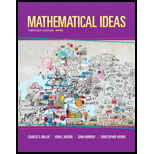
Mathematical Ideas (13th Edition) - Standalone book
13th Edition
ISBN: 9780321977076
Author: Charles D. Miller, Vern E. Heeren, John Hornsby, Christopher Heeren
Publisher: PEARSON
expand_more
expand_more
format_list_bulleted
Textbook Question
Chapter 15.4, Problem 18E
Violations of the Quota Rule? For each apportionment situation in Exercises 17-20, determine whether the quota rule is violated by (a) the Huntington-Hill method and (b) the Adams method. See Exercises 21-24 of Section 15.3. Whenever a violation occurs, note whether the method apportions a state too many or too few seats.
100 seats are apportioned.
| State | a | b | c | d |
| Population | 86,915 | 4325 | 5400 | 3360 |
Expert Solution & Answer
Want to see the full answer?
Check out a sample textbook solution
Students have asked these similar questions
Consider the apportionment of
60
doctors for a physicians organization. The apportionment using Hamilton's method is shown in the table below. Does the Alabama paradox occur using Hamilton's method if the number of doctors is increased from
60
to
61?
Clinic
A
B
C
D
E
Total
Patients
656
536
515
549
602
2858
Standard quota
13.77
11.25
10.81
11.53
12.64
60.00
Lower quota
13
11
10
11
12
57
Hamilton's apportionment
14
11
11
11
13
60
Complete the table below with the new apportionment for clinics A, B, C, D, and E using a standard divisor rounded to two decimal places.
Clinic
A
B
C
D
E
Total
Patients
656
536
515
549
602
2858
Hamilton's apportionment
?
?
?
?
?
61
Using Webster's Method, if the modified quota is 50,100 and the population for State J is 1, 646,000, then the exact number of seats to be apportioned for State J is
Group of answer choices
33
34
31
32
Which one of the apportionment methods studied does not violate the quota rule?
Group of answer choices
Hamilton's Method
Jefferson's Method
Adam's Method
Webster's Method
Chapter 15 Solutions
Mathematical Ideas (13th Edition) - Standalone book
Ch. 15.1 - Choosing a Poster Dog by the Plurality Method A...Ch. 15.1 - Choosing a Poster Dog by the Plurality Method A...Ch. 15.1 - Choosing a Poster Dog by Alternative Methods For...Ch. 15.1 - Choosing a Poster Dog by Alternative MethodsFor...Ch. 15.1 - Observing the Effect of the Number of Candidates...Ch. 15.1 - Observing the Effect of the Number of Candidates...Ch. 15.1 - Observing the Effect of the Number of Candidates...Ch. 15.1 - Observing the Effect of the Number of Candidates...Ch. 15.1 - Observing the Effect of the Number of Candidates...Ch. 15.1 - Observing the Effect of the Number of Candidates...
Ch. 15.1 - Applying Four Voting Methods to a Voter Profile...Ch. 15.1 - Applying Four Voting Methods to a Voter Profile...Ch. 15.1 - Applying Four Voting Methods to a Voter Profile...Ch. 15.1 - Applying Four Voting Methods to a Voter Profile...Ch. 15.1 - Applying Four Voting Methods to a Voter Profile...Ch. 15.1 - Applying Four Voting Methods to a Voter Profile...Ch. 15.1 - Applying Four Voting Methods to a Voter Profile...Ch. 15.1 - Applying Four Voting Methods to a Voter Profile...Ch. 15.1 - Holding a Runoff Election One common solution to...Ch. 15.1 - Prob. 20ECh. 15.1 - Prob. 21ECh. 15.1 - Prob. 22ECh. 15.1 - Prob. 23ECh. 15.1 - Prob. 24ECh. 15.1 - Prob. 25ECh. 15.1 - Prob. 26ECh. 15.1 - Prob. 27ECh. 15.1 - The Pairwise Comparison Method Each table...Ch. 15.1 - Prob. 29ECh. 15.1 - Prob. 30ECh. 15.1 - The Borda Method Each table represents a Borda...Ch. 15.1 - Prob. 32ECh. 15.1 - Prob. 33ECh. 15.1 - Prob. 34ECh. 15.1 - Prob. 35ECh. 15.1 - Prob. 36ECh. 15.1 - The Coombs Method The Coombs method of voting is a...Ch. 15.1 - Prob. 38ECh. 15.1 - Prob. 39ECh. 15.1 - Prob. 40ECh. 15.2 - Identifying Violations of the Majority Criterion...Ch. 15.2 - Identifying Violations of the Majority Criterion...Ch. 15.2 - Identifying Violations of the Majority...Ch. 15.2 - Identifying Violations of the Majority Criterion...Ch. 15.2 - Identifying Violations of the Condorcet...Ch. 15.2 - Identifying Violations of the Condorcet Criterion...Ch. 15.2 - Identifying Violations of the Condorcet Criterion...Ch. 15.2 - Identifying Violations of the Condorcet Criterion...Ch. 15.2 - Prob. 9ECh. 15.2 - Prob. 10ECh. 15.2 - Prob. 11ECh. 15.2 - Prob. 12ECh. 15.2 - Prob. 13ECh. 15.2 - Prob. 14ECh. 15.2 - Prob. 15ECh. 15.2 - Prob. 16ECh. 15.2 - Prob. 17ECh. 15.2 - Prob. 18ECh. 15.2 - Prob. 19ECh. 15.2 - Irrelevant Alternatives in a Hare Method Election...Ch. 15.2 - 21. Explain why a violation of the majority...Ch. 15.2 - Prob. 22ECh. 15.2 - Prob. 23ECh. 15.2 - Prob. 24ECh. 15.2 - Prob. 25ECh. 15.2 - Prob. 26ECh. 15.2 - Prob. 27ECh. 15.2 - Prob. 28ECh. 15.2 - Prob. 29ECh. 15.2 - Prob. 30ECh. 15.2 - Prob. 31ECh. 15.2 - Prob. 32ECh. 15.2 - Prob. 33ECh. 15.2 - Prob. 34ECh. 15.3 - Find each quantity (to the nearest whole number)...Ch. 15.3 - Find each quantity (to the nearest whole number)...Ch. 15.3 - Find each quantity (to the nearest whole number)...Ch. 15.3 - Find each quantity (to the nearest whole number)...Ch. 15.3 - Solve each problem.
5. New Trees for Wisconsin...Ch. 15.3 - Apportioning Computers to Schools Enrollments for...Ch. 15.3 - Assigning Faculty to Courses The English...Ch. 15.3 - 8. Apportioning Sailboats to Resorts The number of...Ch. 15.3 - Prob. 9ECh. 15.3 - 10. Show that the Webster method apportionment of...Ch. 15.3 - Prob. 11ECh. 15.3 - Prob. 12ECh. 15.3 - Prob. 13ECh. 15.3 - Prob. 14ECh. 15.3 - Prob. 15ECh. 15.3 - Find the Huntington-Hill cutoff point for rounding...Ch. 15.3 - Creating a Profile of School Bus Riders Create a...Ch. 15.3 - Prob. 18ECh. 15.3 - Prob. 19ECh. 15.3 - Prob. 20ECh. 15.3 - The standard quotas rounded up to the nearest...Ch. 15.3 - Prob. 22ECh. 15.3 - Prob. 23ECh. 15.3 - Prob. 24ECh. 15.4 - Quota Rule Violations with the Jefferson Method In...Ch. 15.4 - Quota Rule Violations with the Jefferson Method In...Ch. 15.4 - Quota Rule Violations with the Jefferson Method In...Ch. 15.4 - Quota Rule Violations with the Jefferson Method In...Ch. 15.4 - Alabama Paradox with the Hamilton Method In each...Ch. 15.4 - Alabama Paradox with the Hamilton Method In each...Ch. 15.4 - Alabama Paradox with the Hamilton Method In each...Ch. 15.4 - Alabama Paradox with the Hamilton Method In each...Ch. 15.4 - Population Paradox with the Hamilton Method In...Ch. 15.4 - Population Paradox with the Hamilton Method In...Ch. 15.4 - Population Paradox with the Hamilton Method In...Ch. 15.4 - Population Paradox with the Hamilton Method In...Ch. 15.4 - New States Paradox with the Hamilton Method In...Ch. 15.4 - New States Paradox with the Hamilton Method In...Ch. 15.4 - New States Paradox with the Hamilton Method In...Ch. 15.4 - New States Paradox with the Hamilton Method In...Ch. 15.4 - Violations of the Quota Rule? For each...Ch. 15.4 - Violations of the Quota Rule? For each...Ch. 15.4 - Violations of the Quota Rule? For each...Ch. 15.4 - Prob. 20ECh. 15.4 - Prob. 21ECh. 15.4 - Prob. 22ECh. 15.4 - Prob. 23ECh. 15.4 - Prob. 24ECh. 15.4 - Prob. 25ECh. 15.4 - 26. The Jefferson and Adams methods are both...Ch. 15 - How many different complete rankings are possible...Ch. 15 - Prob. 2TCh. 15 - Prob. 3TCh. 15 - Prob. 4TCh. 15 - Prob. 5TCh. 15 - Why is the irrelevant alternatives criterion an...Ch. 15 - Prob. 7TCh. 15 - Prob. 8TCh. 15 - Prob. 9TCh. 15 - Prob. 10TCh. 15 - Prob. 11TCh. 15 - Prob. 12TCh. 15 - Prob. 13TCh. 15 - Prob. 14TCh. 15 - Prob. 15TCh. 15 - Prob. 16TCh. 15 - Prob. 17TCh. 15 - Prob. 18TCh. 15 - Prob. 19TCh. 15 - Prob. 20TCh. 15 - Prob. 21TCh. 15 - Prob. 22TCh. 15 - Prob. 23TCh. 15 - Prob. 24TCh. 15 - Prob. 25TCh. 15 - One hundred seats are to be apportioned to 4...Ch. 15 - Prob. 27TCh. 15 - Prob. 28TCh. 15 - Prob. 29TCh. 15 - Explain the Alabama paradox.Ch. 15 - Prob. 31TCh. 15 - Prob. 32T
Knowledge Booster
Learn more about
Need a deep-dive on the concept behind this application? Look no further. Learn more about this topic, subject and related others by exploring similar questions and additional content below.Recommended textbooks for you
 Discrete Mathematics and Its Applications ( 8th I...MathISBN:9781259676512Author:Kenneth H RosenPublisher:McGraw-Hill Education
Discrete Mathematics and Its Applications ( 8th I...MathISBN:9781259676512Author:Kenneth H RosenPublisher:McGraw-Hill Education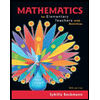 Mathematics for Elementary Teachers with Activiti...MathISBN:9780134392790Author:Beckmann, SybillaPublisher:PEARSON
Mathematics for Elementary Teachers with Activiti...MathISBN:9780134392790Author:Beckmann, SybillaPublisher:PEARSON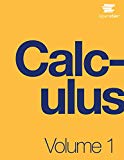
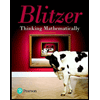 Thinking Mathematically (7th Edition)MathISBN:9780134683713Author:Robert F. BlitzerPublisher:PEARSON
Thinking Mathematically (7th Edition)MathISBN:9780134683713Author:Robert F. BlitzerPublisher:PEARSON Discrete Mathematics With ApplicationsMathISBN:9781337694193Author:EPP, Susanna S.Publisher:Cengage Learning,
Discrete Mathematics With ApplicationsMathISBN:9781337694193Author:EPP, Susanna S.Publisher:Cengage Learning,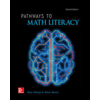 Pathways To Math Literacy (looseleaf)MathISBN:9781259985607Author:David Sobecki Professor, Brian A. MercerPublisher:McGraw-Hill Education
Pathways To Math Literacy (looseleaf)MathISBN:9781259985607Author:David Sobecki Professor, Brian A. MercerPublisher:McGraw-Hill Education

Discrete Mathematics and Its Applications ( 8th I...
Math
ISBN:9781259676512
Author:Kenneth H Rosen
Publisher:McGraw-Hill Education

Mathematics for Elementary Teachers with Activiti...
Math
ISBN:9780134392790
Author:Beckmann, Sybilla
Publisher:PEARSON


Thinking Mathematically (7th Edition)
Math
ISBN:9780134683713
Author:Robert F. Blitzer
Publisher:PEARSON

Discrete Mathematics With Applications
Math
ISBN:9781337694193
Author:EPP, Susanna S.
Publisher:Cengage Learning,

Pathways To Math Literacy (looseleaf)
Math
ISBN:9781259985607
Author:David Sobecki Professor, Brian A. Mercer
Publisher:McGraw-Hill Education
Graph Theory: Euler Paths and Euler Circuits; Author: Mathispower4u;https://www.youtube.com/watch?v=5M-m62qTR-s;License: Standard YouTube License, CC-BY
WALK,TRIAL,CIRCUIT,PATH,CYCLE IN GRAPH THEORY; Author: DIVVELA SRINIVASA RAO;https://www.youtube.com/watch?v=iYVltZtnAik;License: Standard YouTube License, CC-BY